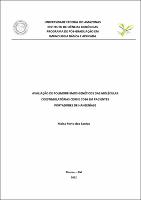| ???jsp.display-item.social.title??? |


|
Please use this identifier to cite or link to this item:
https://tede.ufam.edu.br/handle/tede/4912| ???metadata.dc.type???: | Dissertação |
| Title: | Avaliação de polimorfismos genéticos das moléculas coestimulatórias CD80 e CD86 em pacientes portadores de hanseníase |
| ???metadata.dc.creator???: | Santos, Maisa Porto dos  |
| ???metadata.dc.contributor.advisor1???: | Paula, Lúcia de |
| First advisor-co: | Naveca, Felipe Gomes |
| ???metadata.dc.description.resumo???: | A hanseníase é uma doença infecciosa crônica causada pelo Mycobacterium leprae que é influenciada por aspectos genéticos do hospedeiro. Os pólos da hanseníase são ocupados por espectros imunológicos opostos, de um lado pela forma tuberculoide, com predominante resposta imunológica Th1 e do outro pela forma virchowiana, com predominante resposta Th2. Durante o desenvolvimento da resposta imune, além do sinal antígeno-específico é necessário um segundo sinal para ativação dos linfócitos T, denominado coestimulação. Este sinal pode ser fornecido pelas moléculas CD80 e CD86 presentes nas superfícies das células apresentadoras de antígenos. A ligação destas moléculas aos receptores CD28 e CTLA-4 presentes nos linfócitos T conduz à ativação ou à inibição da resposta imune, respectivamente. A baixa regulação de CD80 e CD28 em pacientes com hanseníase borderline virchowiana ou virchowiana pode ser responsável pela defeituosa sinalização de células T específicas para os antígenos de M. leprae pela via CD80/CD28. Isto pode levar à inativação clonal de células T reativas aos antígenos de M. leprae e, consequentemente, o bacilo cresceria sem restrição nos macrófagos. No presente trabalho foi investigada a possível relação entre polimorfismos presentes nos genes CD80 e CD86 com a susceptibilidade à hanseníase e/ou às formas clínicas da doença. A genotipagem dos polimorfismos foi realizada pelo método de sequenciamento direto. Foram analisados no gene CD80 seis SNP localizados na região promotora (-454 C/A, -387 T/C, -232 G/A, -79 C/G, -7T/C e +5C/A) e um polimorfismo de inserção/deleção (-557_-561 CATGA) e no gene CD86 foi analisado um SNP no éxon 8, posição +1057G/A. Quanto ao gene CD86 foi observada distribuição genotípica semelhante entre os pacientes e indivíduos controles, sendo os genótipos G/G e G/A os mais prevalentes em ambas as populações. Também não foram observadas diferenças significativas entre as frequências alélicas e genotípicas entre os pacientes com hanseníase e indivíduos controles referentes aos polimorfismos do gene CD80. Embora CD80 e CD86 tenham funções importantes na resposta imune os dados obtidos neste estudo demonstram que os polimorfismos analisados não têm influência na susceptibilidade à hanseníase e/ou diferentes formas clínicas da hanseníase. |
| Abstract: | Leprosy is a chronic infectious disease caused by Mycobacterium leprae that is influenced by host genetic. The poles of the leprosy are occupied by spectrum immunological opposite of the tuberculoid one hand, predominantly of the Th1 immune response and the other by the lepromatous, with predominant Th2 immune response. During the development of immune response, beyond antigen-specific signal is necessary a second signal for activation of T lymphocytes, termed costimulation. This signal can be delivered by costimulatory molecules CD80 and CD86 present on cell surfaces of antigen presented. The binding of these molecules to the receptors CD28 and CTLA-4 T lymphocytes present in the leads to the activation or inhibition of immune response, respectively. The down-regulation of CD80 and CD28 in patients with lepromatous leprosy, and lepromatous borderline can be responsible for defective signaling T cell specific for the antigens of M. leprae through CD80/CD28. This can lead to clonal inactivation of T cells reactive to antigens of M. leprae, and consequently, the bacillus grows without restraint in macrophages. In this work we investigated the possible relationship between this polymorphism in the CD80 and CD86 genes with susceptibility to leprosy and/or clinical forms of the disease. Genotyping of polymorphisms was performed by direct sequencing. CD80 were analyzed six gene SNPs located in the gene promoter region (-454 C/A, -387 T/C, -232 G/A, -79 C/G,-7 T/C and +5 C/A) and Polymorphism insertion/deletion (-557_-561 CATGA) and the CD86 gene was analyzed a SNP in exon 8, position +1057 G/A. For the CD86 gene was observed a similar genotype distribution among leprosy patients and control subjects, and the genotypes G/G and G/A the most prevalent in both populations. There were also no significant differences between the allelic and genotypic frequencies among leprosy patients and healthy controls regarding the polymorphisms of the CD80 gene. Although CD80 and CD86 have important functions in the immune response data obtained in this study demonstrate that the analyzed polymorphisms do not influence the susceptibility to leprosy and/or different clinical forms of leprosy. |
| Keywords: | Hanseníase Polimorfismo Moléculas Coestimulatórias |
| ???metadata.dc.subject.cnpq???: | CIÊNCIAS DA SAÚDE: SAÚDE COLETIVA |
| Language: | por |
| ???metadata.dc.publisher.country???: | Brasil |
| Publisher: | Universidade Federal do Amazonas |
| ???metadata.dc.publisher.initials???: | UFAM |
| ???metadata.dc.publisher.department???: | Faculdade de Medicina |
| ???metadata.dc.publisher.program???: | Programa de Pós-graduação em Imunologia Básica e Aplicada |
| Citation: | SANTOS, Maisa Porto dos. Avaliação de polimorfismos genéticos das moléculas coestimulatórias CD80 e CD86 em pacientes portadores de hanseníase. 2012. 87f. Dissertação (Mestrado em Imunologia Básica e Aplicada) - Universidade Federal do Amazonas, Manaus, 2012. |
| ???metadata.dc.rights???: | Acesso Aberto |
| URI: | http://tede.ufam.edu.br/handle/tede/4912 |
| Issue Date: | 1-Jun-2012 |
| Appears in Collections: | Mestrado em Imunologia Básica e Aplicada |
Files in This Item:
| File | Description | Size | Format | |
|---|---|---|---|---|
| Dissertação_Maisa P. Santos.pdf | 2.76 MB | Adobe PDF |  Download/Open Preview |
Items in DSpace are protected by copyright, with all rights reserved, unless otherwise indicated.




